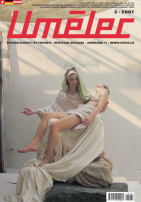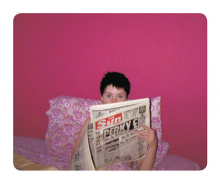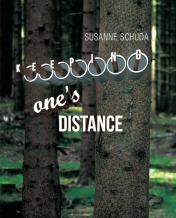| Umělec 2007/3 >> Darina Alster | Просмотр всех номеров | ||||||||||||
|
|||||||||||||
Darina AlsterUmělec 2007/301.03.2007 Madla Bažantová | new face | en cs de es |
|||||||||||||
|
You can say that I’m bisexual, perverse, that like to get high, and that I’m a bitch…yeah, write that down too!
During her performances, Darina Alster switches her sex, gives herself out and seeks her double. With her natural-born exhibitionism as well as her physical beauty as loyal allies, she beckons her audience into her privacy and further into her archetypal world where androgyny and body exchange are taken for granted. When not making love, she tries to create borders, break them down and transgress them. She achieves this with the help of sex, telepathy, drugs, and performance. It isn’t so much that she eradicates borders; rather, it appears that Darina has no borders whatsoever. Her focus is on a certain type of direct energy rather than what the majority of us consider everyday reality; this is apparent in her piece entitled Konkurz (Audition). She placed a classified ad seeking her own body double that was directed to arrive at a certain time at her improvised small office. Darina was probably the only one present who was convinced that any of the respondents actually resembled her. At other times she appeared on Wenceslas Square clad only in costume jewelry, a beautiful living treasure handing out pieces of herself to passers by. In her piece Okno (Window), she transforms herself from one person into another. Scrutinized by her audience, she meticulously applied every conceivable form of make- -up until she achieved the appearance of the twisted lady who inhabited the heating duct in David Lynch’s epic Eraserhead. She also attempts to distill a certain order from this seeming chaos. She succeeds at this with the aid of drawings, cosmic systems; eclectic philosophy bundled with mysticism, the Kabbala, Buddhism, magic and bits of science. In this slew she finds comfort in the balance of energies and the fact that what goes around, comes around. “When you really despise someone, something evil does actually happen to them.” Darina knows very well what she is talking about and really does forgive those that she has in the past eagerly pursued with a knife. She measures and cordons off spaces in an attempt to categorize unfathomable reality. She depicts their energy with the help of interrelationships. She constructs cubes, the ideal containers for reason and she separates bits of chaos into them in accordance with particular keys. With the same obsession she has, for a long time, been trying to comprehend time. For two years she has measured it, documented it and displayed it for others. For my birthday present she gave me a few moments of her precious time. A few sheets of paper in the shape of a tram ticket, each one with an orange tourniquet stamp, in minute-by-minute sequences. In her piece Techno, forty voices speak simultaneously. Again, she works with rhythm, emotions imbedded in the vowels and consonants of edited statements, as well as the order emanating from seeming chaos. She gathered the voices in Techno during her piece Confession. Three people enter into a chamber with three cubicles, the one in the center listens voices of evil and good coming from both sides at the same time. Darina’s undercurrents are strong emotions, emanating from her persona, controlling her destinies and soaking through her projects. It is natural for her to strongly feel rhythm, to sing and to experience poetry, including the negatives. She uses strong words and concepts such as love and murder, good and evil, giving and taking, construction and destruction, life and death. This is not only in her performance pieces, such as the ritual of organizing her own funeral, but in her life as well. After she buried her mother in Stromovka Park, decorated in the finest of jewels, I saw her dying on the beach in Valencia. She sat there in the middle of a pool of blood and did not cry. Two days afterwards, she was dancing a Sufi inspired dance underneath fiery oranges, a tribute to the passing of her t-shirt. She works with her sexuality differently than feminists; there isn’t that typical intellectual distance or antagonizing comments about social norms. She uses sensuality as a force, similar to radioactivity, a force that indiscriminately affects all and everyone around it. This is also when she is screaming her deepest emotions into a public telephone, when she is performing a striptease for dogs in a shelter or when she is dying of love for a multitude of people at the same time. Her work is as intuitive, as intertwined with Darina’s own self-destructive life as her tendencies and her passions. That is not very fashionable these days, especially in an era where three fourths of the art market is formed by reflexive art represented by curators and art critics, and I cannot overlook the cliché that majority of them are men. Men from a generation whose standard rule is that of Joseph Kosuth. From their myopic viewpoint, Darina’s art can in fact be perceived as naïve and contrived. This year she graduated from AVU with a congenial video-Tarot. Twenty-two stories depicting the twenty-two Tarot symbols are played simultaneously, but only one symbol is visible on the video monitor, one selected by the viewer by the touch of their finger. It is a visual commentary on parallel worlds, a fact taken for granted by Darina. A fact that cannot be comprehended but that can be accepted. “I am fascinated by the interconnectivity of the latest technologies and the most traditional of media. The Tarot, psychological interpretations, performance for video, film or a touch-screen—that is the interconnection between the borders of technology and touch when, as a young child, you point, “Here!” Darina Alster is an agent of the subconscious. Reason is given the role of a sports commentator following a football match, thinking that he is the world’s best expert who commands and controls all, but at the same time driven by occurrences and unable to comment on that which is before him. The danger of madness creeps in, the commentator resigns and leaves the scene. So in order to remain sane you must stop taking your reason so seriously, says Darina while diligently rolling a joint. Her work is a bridge between her sub consciousness and her audience. She leaves the commentator’s reason outside and participants of her events should not rely on it too much. Many of them do not come to terms with it.
01.03.2007
Рекомендуемые статьи
|
|||||||||||||
|
04.02.2020 10:17
Letošní 50. ročník Art Basel přilákal celkem 93 000 návštěvníků a sběratelů z 80 zemí světa. 290 prémiových galerií představilo umělecká díla od počátku 20. století až po současnost. Hlavní sektor přehlídky, tradičně v prvním patře výstavního prostoru, představil 232 předních galerií z celého světa nabízející umění nejvyšší kvality. Veletrh ukázal vzestupný trend prodeje prostřednictvím galerií jak soukromým sbírkám, tak i institucím. Kromě hlavního veletrhu stály za návštěvu i ty přidružené: Volta, Liste a Photo Basel, k tomu doprovodné programy a výstavy v místních institucích, které kvalitou daleko přesahují hranice města tj. Kunsthalle Basel, Kunstmuseum, Tinguely muzeum nebo Fondation Beyeler.
|







.jpg.detailThumb.png)

.jpg.thumb.png)























 New book by I.M.Jirous in English at our online bookshop.
New book by I.M.Jirous in English at our online bookshop.
Комментарии
Статья не была прокомментированаДобавить новый комментарий